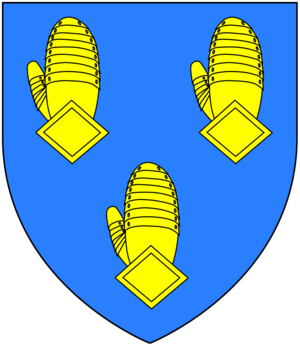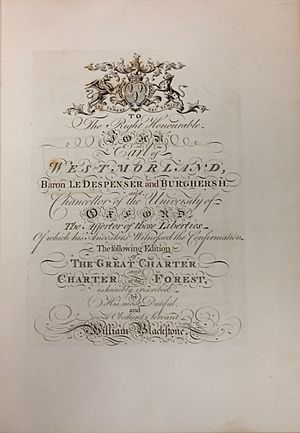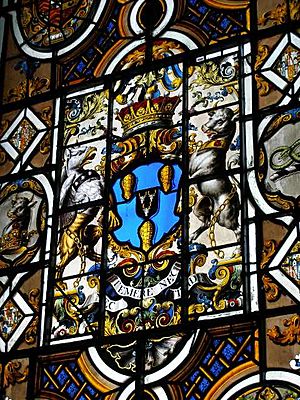John Fane, 7th Earl of Westmorland facts for kids
Quick facts for kids
General The Right Honourable
The Earl of Westmorland
|
|
|---|---|

Arms of Fane: Azure, three dexter gauntlets back affrontée or
|
|
| Member of Parliament for Buckingham | |
| In office March 1727 – 1728 |
|
| Monarch | George I George II |
| Preceded by | William Heathcote Richard Grenville |
| Succeeded by | George Chamberlayne Richard Grenville |
| Member of Parliament for Kent | |
| In office September 1715 – 1722 Serving with William Delaune
|
|
| Monarch | George I |
| Preceded by | Mildmay Fane |
| Succeeded by | Sir Edward Knatchbull Sir Thomas Twisden |
| Member of Parliament for Hythe | |
| In office 1708–1711 Serving with John Boteler
The Viscount Shannon |
|
| Monarch | Anne |
| Preceded by | Sir Philip Boteler John Boteler |
| Succeeded by | John Boteler William Berners |
| Chancellor of the University of Oxford | |
| In office 1759–1762 |
|
| Preceded by | The Earl of Arran |
| Succeeded by | The Earl of Lichfield |
| Personal details | |
| Born |
John Fane
24 March 1685 |
| Died | 26 August 1762 (aged 77) |
| Nationality | English |
| Spouse | Mary Cavendish |
| Parents | Vere Fane, 4th Earl of Westmorland Rachel Bence |
| Military service | |
| Allegiance | |
| Branch/service | British Army |
| Years of service | 1709–1761 |
| Rank | General |
| Commands | John Fane's Regiment of Foot 1st Troop Horse Grenadier Guards His Majesty's Own Troop of Horse Guards |
| Battles/wars | Battle of Oudenarde Siege of Lille Battle of Malplaquet |
John Fane, the 7th Earl of Westmorland (born March 24, 1685 – died August 26, 1762), was an important figure in British history. He was known as "The Honourable John Fane" and later "Lord Catherlough." He lived at Mereworth Castle in Kent, England. John Fane was both a soldier in the British Army and a politician. He served as a Member of Parliament (MP) in the House of Commons at different times between 1708 and 1734.

Contents
Who Was John Fane?
John Fane was a significant person in 18th-century Britain. He held important roles in both the military and politics. He also inherited a noble title, becoming the Earl of Westmorland. His life shows how people could be involved in many different areas during that time.
His Family and Titles
John Fane was the son of Vere Fane, 4th Earl of Westmorland and Rachel Bence. He had two older brothers, Vere Fane and Thomas Fane. Both of his older brothers passed away without having children. Because of this, John Fane became the next in line to inherit the family titles. He eventually became the 7th Earl of Westmorland.
How He Became Wealthy
John Fane outlived many of his brothers and sisters. He was the only male heir left in his direct family line. This meant he inherited most of their properties and wealth. His money grew even more when he received an inheritance from his younger brother, Mildmay Fane. He also earned money from his lands in Caterlough, Ireland.
His Life as a Soldier and Politician
John Fane had a long and active career. He was involved in both law and military service. He also spent many years serving in the British Parliament.
Early Career and Battles
John Fane began studying law in 1703 at Lincoln's Inn. He also attended Emmanuel College, Cambridge. In 1708, he became a Member of Parliament (MP) for Hythe. He held this position until 1711.
That same year, he joined the army. He fought in important battles like the Battle of Oudenarde and the Siege of Lille. After these battles, he returned to England. The Duke of Marlborough, a famous general, praised Fane's bravery. He wrote that Fane "behaved himself very well." A year later, Fane went back to the continent. He served as a Captain and fought in the Battle of Malplaquet.
From Whig to Tory
John Fane was re-elected as an MP for Hythe in 1709 and 1710. However, he lost his seat in 1711 after a challenge from other candidates. He later became an MP for Kent from 1715 to 1722. Then, he represented Buckingham from 1727 to 1734.
He started his political career as a Whig. However, he later changed his political views. During the reign of King George II, he became a Tory.
Later Military Ranks and Titles
John Fane continued to rise in the British Army. He reached the rank of colonel in the Horse Guards. In 1761, he became a general. In 1733, he was given a new title: the 1st Baron Catherlough in Ireland. Three years later, in 1736, he inherited the title of 7th Earl of Westmorland from his older brother. He also hired a famous architect, Colen Campbell, to build his beautiful home, Mereworth Castle, in Kent.
His Marriage and Legacy
In 1716, John Fane married Mary Cavendish. She was the only daughter of Lord Henry Cavendish. They did not have any children together.
What Happened After He Died?
John Fane passed away in 1762. Since he had no children, his Irish barony (Baron Catherlough) ended. Another title, the barony of Le Despencer, went to his nephew, Sir Francis Dashwood. The earldom of Westmorland went to his distant cousin, Thomas Fane, 8th Earl of Westmorland. Thomas Fane was a merchant from Bristol.


